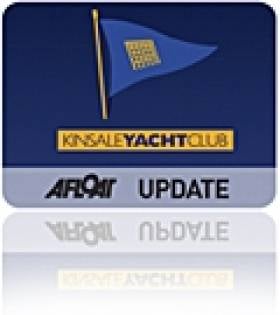Displaying items by tag: Bruce Mathews
Strong Winds for Kinsale League
With the Laser Fleets not launching until the last minute, they however mistimed the 11.55 First Gun. After a short postponement, the Squib Class who had been reveling in the pre-start conditions was the first fleet to compete. The strong winds persisted throughout the first race with each squall prompting a flurry of capsizing Lasers as one Squib got into difficulties against the lee shore at Jarley's Cove. As the winds moderated to a force five, with the slackening tide and a calmer sea the remaining two races enjoyed easier if still challenging conditions. The decision to combine the three Laser fleets into one start, and the Squibs with the Mixed Dinghies led to the better management of the last two races given the conditions.
The previously unassailable form of Marcus Hutchinson (KYC) helming 'Sensation', was put under greater pressure in the Squib Fleet, with Victor Fusco and crew James Bendon (KYC) on Gemini notably claiming a first place in the second race. However with his crew Ben Fusco, Marcus took line honours in the other two races bringing his total of wins to five out of a possible six; as two discards now apply. Realistically, with next Sunday being the final day of racing and with eight points behind the leader, Gemini will be hoping to secure the second place overall. With a second in the first race adding to his overall score, he is now just two points ahead of the consistent Colm Dunne and Mark Buckley (KYC) who have moved up a place aided by an excellent second in the third race. Having an unsuccessful day due to a sixth in the first race and not completing the last two, Paul McCarthy (KYC) in Mack drops two places to a fourth overall. On only one point adrift he is still very much in contention for a top three placing.
In the Laser Standard Class Rob Howe (RCYC), though obviously comfortable in the strong breeze, did not quite repeat last week's clean sweep of wins. Nevertheless, with one second and two firsts he retains his overall position in the fleet on seven points overall. David Kenefick (RCYC) took advantage by winning the first race, and his subsequent two seconds puts him on just two points behind the leader going into the final day next Sunday. Having now discarded his worst two scores due to missing the first race day, Paul O' Sullivan (RCYC) continued his consistent form with a further three thirds, and is now in third place overall.
Eoin Keller (LDYC), the previous clear leader in the Laser Radial Class and unable to compete this week, slips dramatically from a total of four points to fifteen points and into second place overall. Eoghan Cudmore (KYC) with a splendid second and two wins on Sunday leaps from third into first place overall. Sean Murphy (KYC) who scored a third and two seconds positions himself just one point behind Keller. With very little between the top three, it will take the remaining races to decide final outcome.
Due to other sailing commitments for the young Laser 4.7 fleet, there has been much changing in the league position over the past few weeks; apart from Cian Byrne (KYC/RCYC) who has resolutely held onto the top position from day one. A close and exciting tussle has finally emerged between Cian and Dara O'Shea (KYC), who despite being on the wrong side of a protest decision in the first race, recovered well to gain a subsequent second and first. He has given himself a chance being well positioned just three points behind overall. Conor Murphy (KYC) with an excellent day's achievement of a first and two seconds has shot up the league table into third place overall.
Brian Jones and Gary Frost (MBSC) in their 505 continued unchallenged with a further three bullets in the Mixed Dinghy Class, with the Fevas of David Marshall/Rob Scandrett and Fiona Lynch/Sofie Kelleher in second and third overall.
The ASM Frostbite League at KYC will be completed next Sunday, 27th February 2011. First Gun is at 11.55 a.m.
























































